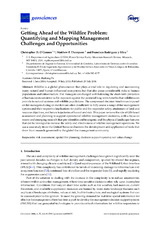Getting Ahead of the Wildfire Problem: Quantifying and Mapping Management Challenges and Opportunities
Autor
O'Connor, Christopher D.
Thompson, Matthew P.
Rodríguez y Silva, Francisco
Editor
MDPIFecha
2016Materia
Risk assessmentSpatial fire planning
Decision support systems (DSS)
Net value change
METS:
Mostrar el registro METSPREMIS:
Mostrar el registro PREMISMetadatos
Mostrar el registro completo del ítemResumen
Wildfire is a global phenomenon that plays a vital role in regulating and maintaining
many natural and human-influenced ecosystems but that also poses considerable risks to human
populations and infrastructure. Fire managers are charged with balancing the short-term protection
of human assets sensitive to fire exposure against the potential long-term benefits that wildfires can
provide to natural systems and wildlife populations. The compressed decision timeframes imposed
on fire managers during an incident are often insufficient to fully assess a range of fire management
options and their respective implications for public and fire responder safety, attainment of land and
resource objectives, and future trajectories of hazard and risk. This paper reviews the role of GIS-based
assessment and planning to support operational wildfire management decisions, with a focus on
recent and emerging research that pre-identifies anthropogenic and biophysical landscape features
that can be leveraged to increase the safety and effectiveness of wildfire management operations. We
use a case study from the United States to illustrate the development and application of tools that
draw from research generated by the global fire management community

